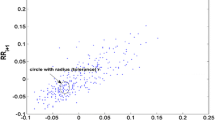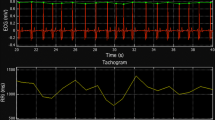Abstract
This study presents an alternative approach to approximate entropy (ApEn) threshold value (r) selection. There are two limitations of traditional ApEn algorithm: (1) the occurrence of undefined conditional probability (CPu) where no template match is found and (2) use of a crisp tolerance (radius) threshold ‘r’. To overcome these limitations, CPu is substituted with optimum bias setting ɛ opt which is found by varying ɛ from (1/N − m) to 1 in the increments of 0.05, where N is the length of the series and m is the embedding dimension. Furthermore, an alternative approach for selection of r based on binning the distance values obtained by template matching to calculate ApEnbin is presented. It is observed that ApEnmax, ApEnchon and ApEnbin converge for ɛ opt = 0.6 in 50 realizations (n = 50) of random number series of N = 300. Similar analysis suggests ɛ opt = 0.65 and ɛ opt = 0.45 for 50 realizations each of fractional Brownian motion and MIX(P) series (Lu et al. in J Clin Monit Comput 22(1):23–29, 2008). ɛ opt = 0.5 is suggested for heart rate variability (HRV) and systolic blood pressure variability (SBPV) signals obtained from 50 young healthy subjects under supine and upright position. It is observed that (1) ApEnbin of HRV is lower than SBPV, (2) ApEnbin of HRV increases from supine to upright due to vagal inhibition and (3) ApEnbin of BPV decreases from supine to upright due to sympathetic activation. Moreover, merit of ApEnbin is that it provides an alternative to the cumbersome ApEnmax procedure.






Similar content being viewed by others
References
Acharya UR, Joseph KP, Kannathal N, Lim CM, Suri JS (2006) Heart rate variability: a review. Med Biol Eng Comput 44(12):1031–1051
Boettger S, Hoyer D, Falkenhahn K, Kaatz M, Yeragani VK, Bär K-J (2006) Altered diurnal autonomic variation and reduced vagal information flow in acute schizophrenia. Clin Neurophysiol 117(12):2715–2722
Castiglioni P, Parati G, Di Rienzo M, Carabalona R, Cividjian A, Quintin L (2011) Scale exponents of blood pressure and heart rate during autonomic blockade as assessed by detrended fluctuation analysis. J Physiol 589(2):355–369
Chen W, Zhuang J, Yu W, Wang Z (2009) Measuring complexity using FuzzyEn, ApEn, and SampEn. Med Eng Phys 31(1):61–68
Chon KH, Scully C, Lu S (2009) Approximate entropy for all signals. Eng Med Biol Mag IEEE 28(6):18–23
Ferrario M, Signorini MG, Magenes G, Cerutti S (2006) Comparison of entropy-based regularity estimators: application to the fetal heart rate signal for the identification of fetal distress. Biomed Eng IEEE Trans 53(1):119–125
Fleisher LA, Pincus SM, Rosenbaum SH (1993) Approximate entropy of heart rate as a correlate of postoperative ventricular dysfunction. Anesthesiology 78(4):683–692
Goldberger AL (1997) Fractal variability versus pathologic periodicity: complexity loss and stereotypy in disease. (1996). Perspect Biol Med. Summer;40(4):543–61
Goldberger AL, Peng C-K, Lipsitz LA (2002) What is physiologic complexity and how does it change with aging and disease? Neurobiol Aging 23(1):23–26
Javorka M, Trunkvalterova Z, Tonhajzerova I, Javorkova J, Javorka K, Baumert M (2008) Short-term heart rate complexity is reduced in patients with type 1 diabetes mellitus. Clin Neurophysiol 119(5):1071–1081
Javorka M, Lazarova Z, Tonhajzerova I, Turianikova Z, Honzikova N, Fiser B, Javorka K, Baumert M (2011) Baroreflex analysis in diabetes mellitus: linear and nonlinear approaches. Med Biol Eng Comput 49(3):279–288
Katz MJ (1988) Fractals and the analysis of waveforms. Comput Biol Med 18(3):145–156
Koepchen HP (1991) Physiology of rhythms and control systems: an integrative approach. In: Rhythms in physiological systems, pp 3–20. Springer, Berlin
Krstacic G, Parati G, Gamberger D, Castiglioni P, Krstacic A, Steiner R (2012) Heart rate variability and nonlinear dynamic analysis in patients with stress-induced cardiomyopathy. Med Biol Eng Comput 50(10):1037–1046
Lu S, Zhao H, Ju K, Shin K, Lee M, Shelley K, Chon KH (2008) Can photoplethysmography variability serve as an alternative approach to obtain heart rate variability information? J Clin Monit Comput 22(1):23–29
Lu S, Chen X, Kanters JK, Solomon IC, Chon KH (2008) Automatic selection of the threshold value for approximate entropy. Biomed Eng IEEE Trans 55(8):1966–1972
Pincus SM (1994) Greater signal regularity may indicate increased system isolation. Math Biosci 122(2):161–181
Pincus SM, Viscarello RR (1992) Approximate entropy: a regularity measure for fetal heart rate analysis. Obstet Gynecol 79(2):249–255
Pincus SM, Gladstone IM, Ehrenkranz RA (1991) A regularity statistic for medical data analysis. J Clin Monit 7.4:335–345
Porta A, Guzzetti S, Montano N, Pagani M, Somers V, Malliani A, Baselli G, Cerutti S (2000) Information domain analysis of cardiovascular variability signals: evaluation of regularity, synchronisation and co-ordination. Med Biol Eng Comput 38(2):180–188
Porta A, Gnecchi-Ruscone T, Tobaldini E, Guzzetti S, Furlan R, Montano N (2007) Progressive decrease of heart period variability entropy-based complexity during graded head-up tilt. J Appl Physiol 103(4):1143–1149
Porta A, Tobaldini E, Guzzetti S, Furlan R, Montano N, Gnecchi-Ruscone T (2007) Assessment of cardiac autonomic modulation during graded head-up tilt by symbolic analysis of heart rate variability. Am J Physiol Heart Circ Physiol 293(1):H702–H708
Porta A, Gnecchi-Ruscone T, Tobaldini E, Guzzetti S, Furlan R, Montano N (2007) Progressive decrease of heart period variability entropy-based complexity during graded head-up tilt. J Appl Physiol 103(4):1143–1149
Porta A, Guzzetti S, Furlan R, Gnecchi-Ruscone T, Montano N, Malliani A (2007) Complexity and nonlinearity in short-term heart period variability: comparison of methods based on local nonlinear prediction. Biomed Eng IEEE Trans 54(1):94–106
Porta A, Di Rienzo M, Wessel N, Kurths J (2009) Addressing the complexity of cardiovascular regulation. Philos Trans R Soc A Math Phys Eng Sci 367(1892):1215–1218
Porta A, Tobaldini E, Gnecchi-Ruscone T, Montano N (2010) RT variability unrelated to heart period and respiration progressively increases during graded head-up tilt. Am J Physiol Heart Circ Physiol 298(5):H1406–H1414
Porta A, Castiglioni P, Di Rienzo M, Bari V, Bassani T, Marchi A, Takahashi ACM et al (2012) Short-term complexity indexes of heart period and systolic arterial pressure variabilities provide complementary information. J Appl Physiol 113(12):1810–1820
Richman JS, Moorman JR (2000) Physiological time-series analysis using approximate entropy and sample entropy. Am J Physiol-Heart Circ Physiol 278(6):H2039–H2049
Singh B, Singh D (2012) Effect of threshold value r on multiscale entropy based heart rate variability. Cardiovasc Eng Technol 3(2):211–216
Tulppo MP, Mäkikallio TH, Seppänen T, Shoemaker K, Tutungi E, Hughson RL, Huikuri HV (2001) Effects of pharmacological adrenergic and vagal modulation on fractal heart rate dynamics. Clin Physiol 21(5):515–523
Valencia JF, Porta A, Vallverdú M, Claria F, Baranowski R, Orlowska-Baranowska E, Caminal P (2009) Refined multiscale entropy: application to 24-h holter recordings of heart period variability in healthy and aortic stenosis subjects. Biomed Eng IEEE Trans 56(9):2202–2213
Author information
Authors and Affiliations
Corresponding author
Rights and permissions
About this article
Cite this article
Singh, A., Saini, B.S. & Singh, D. An alternative approach to approximate entropy threshold value (r) selection: application to heart rate variability and systolic blood pressure variability under postural challenge. Med Biol Eng Comput 54, 723–732 (2016). https://doi.org/10.1007/s11517-015-1362-z
Received:
Accepted:
Published:
Issue Date:
DOI: https://doi.org/10.1007/s11517-015-1362-z




